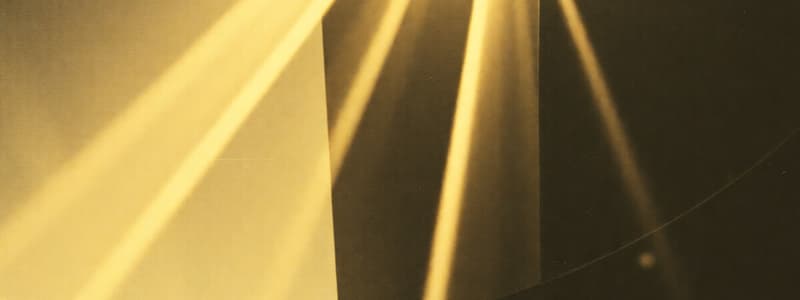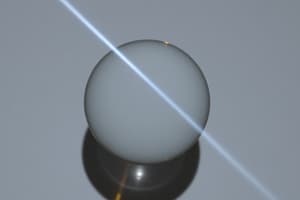Podcast
Questions and Answers
What model describes light propagation in terms of rays?
What model describes light propagation in terms of rays?
- Ray optics (correct)
- Physical optics
- Wave optics
- Quantum optics
In ray optics, how is light assumed to travel?
In ray optics, how is light assumed to travel?
- In curved lines
- In straight lines (correct)
- In random directions
- In circular paths
What happens when light 'bounces off' a surface?
What happens when light 'bounces off' a surface?
- Reflection (correct)
- Diffraction
- Refraction
- Absorption
What is the relationship between the angle of incidence and the angle of reflection?
What is the relationship between the angle of incidence and the angle of reflection?
What is the term for a line perpendicular to the surface at the point where the incident ray strikes?
What is the term for a line perpendicular to the surface at the point where the incident ray strikes?
What type of surface is required for the laws of reflection to hold true?
What type of surface is required for the laws of reflection to hold true?
What type of reflection occurs when parallel incident rays result in parallel reflected rays?
What type of reflection occurs when parallel incident rays result in parallel reflected rays?
What type of reflection scatters light in different directions?
What type of reflection scatters light in different directions?
What kind of image is formed by a plane mirror?
What kind of image is formed by a plane mirror?
Which of the following best describes the image formed by a plane mirror?
Which of the following best describes the image formed by a plane mirror?
What is the relationship between the object distance and the image distance in a plane mirror?
What is the relationship between the object distance and the image distance in a plane mirror?
What is a characteristic of the image formed by a plane mirror?
What is a characteristic of the image formed by a plane mirror?
What is the shape of a spherical mirror?
What is the shape of a spherical mirror?
What is a mirror called if its reflecting surface curves inward?
What is a mirror called if its reflecting surface curves inward?
What is the point on the principal axis where parallel rays converge (concave) or appear to diverge from (convex)?
What is the point on the principal axis where parallel rays converge (concave) or appear to diverge from (convex)?
What is the equation relating focal length ($f$) and radius of curvature ($R$)?
What is the equation relating focal length ($f$) and radius of curvature ($R$)?
If an object is located beyond the center of curvature of a concave mirror, what type of image is formed?
If an object is located beyond the center of curvature of a concave mirror, what type of image is formed?
What type of image do convex mirrors always produce?
What type of image do convex mirrors always produce?
What does a positive magnification indicate?
What does a positive magnification indicate?
Flashcards
Ray Optics
Ray Optics
Simplified model of light propagation using rays.
Reflection
Reflection
Light bouncing off a surface.
Law of Reflection (Plane)
Law of Reflection (Plane)
Incident ray, reflected ray, and normal all lie in the same plane.
Law of Reflection (Angles)
Law of Reflection (Angles)
Signup and view all the flashcards
Specular Reflection
Specular Reflection
Signup and view all the flashcards
Diffuse Reflection
Diffuse Reflection
Signup and view all the flashcards
Plane Mirror
Plane Mirror
Signup and view all the flashcards
Virtual Image
Virtual Image
Signup and view all the flashcards
Spherical Mirrors
Spherical Mirrors
Signup and view all the flashcards
Concave Mirror
Concave Mirror
Signup and view all the flashcards
Convex Mirror
Convex Mirror
Signup and view all the flashcards
Principal Axis
Principal Axis
Signup and view all the flashcards
Focal Point (F)
Focal Point (F)
Signup and view all the flashcards
Focal Length (f)
Focal Length (f)
Signup and view all the flashcards
Convex Mirror Images
Convex Mirror Images
Signup and view all the flashcards
Mirror Equation
Mirror Equation
Signup and view all the flashcards
Magnification (M)
Magnification (M)
Signup and view all the flashcards
Positive Object Distance (u)
Positive Object Distance (u)
Signup and view all the flashcards
Negative Image Distance (v)
Negative Image Distance (v)
Signup and view all the flashcards
Positive Focal Length (f)
Positive Focal Length (f)
Signup and view all the flashcards
Study Notes
- Ray optics, also known as geometrical optics, is a simplified model that describes the propagation of light in terms of rays.
- It assumes that light travels in straight lines and bends only when it encounters an interface between two different media.
- Reflection is a phenomenon where light bounces off a surface.
- Reflection obeys two fundamental laws, the law of reflection defines the angles of incidence and reflection.
Law of Reflection
- The incident ray, the reflected ray, and the normal to the surface at the point of incidence all lie in the same plane.
- The angle of incidence (θi) is equal to the angle of reflection (θr).
- The angles are measured with respect to the normal, which is a line perpendicular to the surface at the point where the incident ray strikes.
- These laws hold true for smooth surfaces, such as mirrors.
Types of Reflection
- Specular reflection occurs when light reflects off a smooth surface.
- In specular reflection, parallel incident rays produce parallel reflected rays.
- This type of reflection creates a clear, mirror-like image.
- Diffuse reflection occurs when light reflects off a rough surface.
- In diffuse reflection, parallel incident rays are scattered in different directions upon reflection.
- This type of reflection does not produce a clear image, but it allows us to see the surface from various angles.
Reflection from Plane Mirrors
- A plane mirror is a flat, smooth surface that reflects light specularly.
- The image formed by a plane mirror is virtual, meaning that the light rays do not actually converge at the image location.
- The image appears to be behind the mirror.
- The image is upright, meaning that it has the same orientation as the object.
- The image is laterally inverted, meaning that the left and right sides are reversed.
- The image is the same size as the object.
- The distance from the object to the mirror is equal to the distance from the image to the mirror.
Reflection from Spherical Mirrors
- Spherical mirrors are curved mirrors that have the shape of a portion of a sphere.
- There are two types of spherical mirrors: concave mirrors and convex mirrors.
- Concave mirrors have a reflecting surface that curves inward.
- Convex mirrors have a reflecting surface that curves outward.
- The principal axis of a spherical mirror is a line that passes through the center of curvature (C) and the vertex (V) of the mirror.
- The vertex is the center of the mirror's surface.
- The focal point (F) of a spherical mirror is the point on the principal axis where parallel rays of light converge after reflection from a concave mirror or appear to diverge from after reflection from a convex mirror.
- The focal length (f) of a spherical mirror is the distance from the vertex to the focal point.
- The radius of curvature (R) of a spherical mirror is the distance from the vertex to the center of curvature.
- The focal length is half the radius of curvature: f = R/2.
Image Formation by Concave Mirrors
- The nature of the image formed by a concave mirror depends on the object's position relative to the focal point and the center of curvature.
- If the object is located beyond the center of curvature (u > 2f): The image is real, inverted, and smaller than the object. It is located between the focal point and the center of curvature (f < v < 2f).
- If the object is located at the center of curvature (u = 2f): The image is real, inverted, and the same size as the object. It is located at the center of curvature (v = 2f).
- If the object is located between the center of curvature and the focal point (f < u < 2f): The image is real, inverted, and larger than the object. It is located beyond the center of curvature (v > 2f).
- If the object is located at the focal point (u = f): No image is formed. The reflected rays are parallel.
- If the object is located between the focal point and the mirror (u < f): The image is virtual, upright, and larger than the object. It is located behind the mirror.
Image Formation by Convex Mirrors
- Convex mirrors always produce virtual, upright, and smaller images, regardless of the object's position.
- The image is located behind the mirror, between the focal point and the mirror.
- Convex mirrors have a wider field of view compared to plane or concave mirrors.
Mirror Equation and Magnification
- The mirror equation relates the object distance (u), the image distance (v), and the focal length (f) of a spherical mirror: 1/f = 1/u + 1/v.
- This equation applies to both concave and convex mirrors, but it is important to use the correct sign conventions.
- The magnification (M) of a spherical mirror is defined as the ratio of the image height (hi) to the object height (ho): M = hi/ho = -v/u.
- A positive magnification indicates an upright image, while a negative magnification indicates an inverted image.
- If |M| > 1, the image is larger than the object.
- If |M| < 1, the image is smaller than the object.
- If |M| = 1, the image is the same size as the object.
Sign Conventions
- Object distance (u): Positive if the object is in front of the mirror (real object), negative if the object is behind the mirror (virtual object).
- Image distance (v): Positive if the image is in front of the mirror (real image), negative if the image is behind the mirror (virtual image).
- Focal length (f): Positive for concave mirrors, negative for convex mirrors.
- Radius of curvature (R): Positive for concave mirrors, negative for convex mirrors.
- Image height (hi): Positive for upright images, negative for inverted images.
Studying That Suits You
Use AI to generate personalized quizzes and flashcards to suit your learning preferences.




